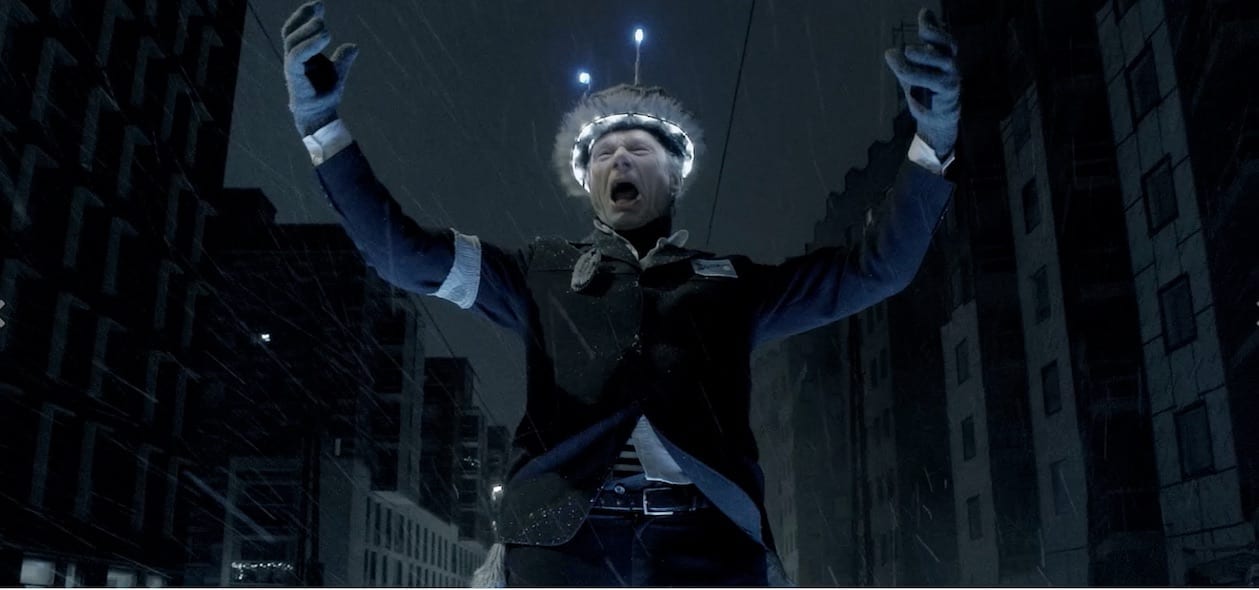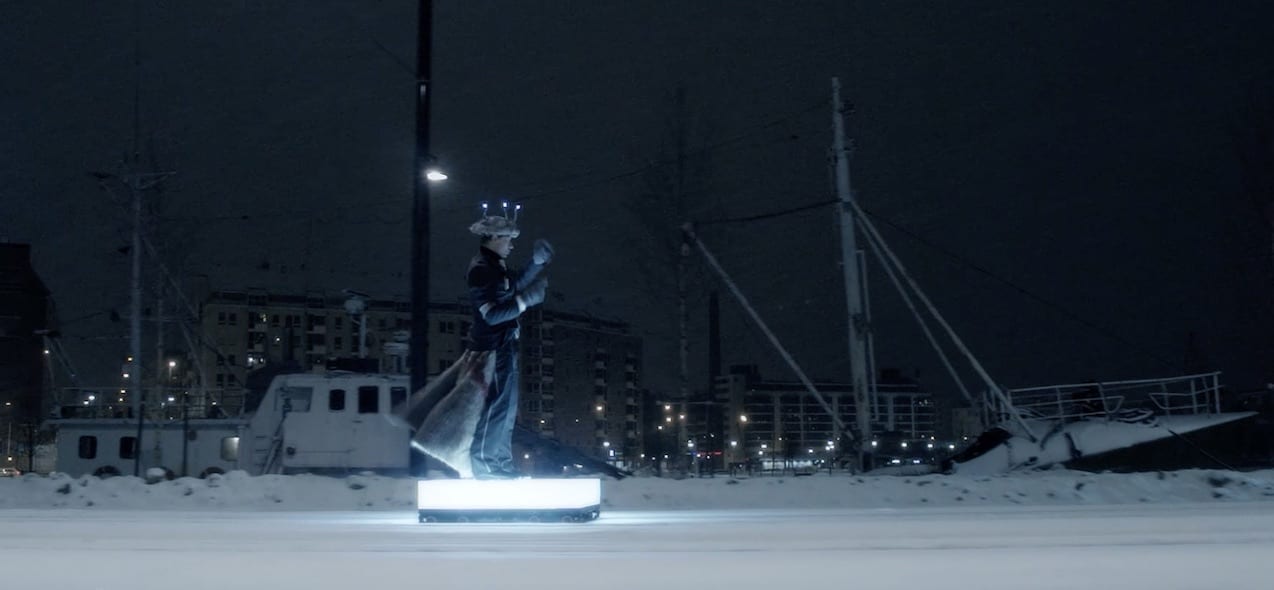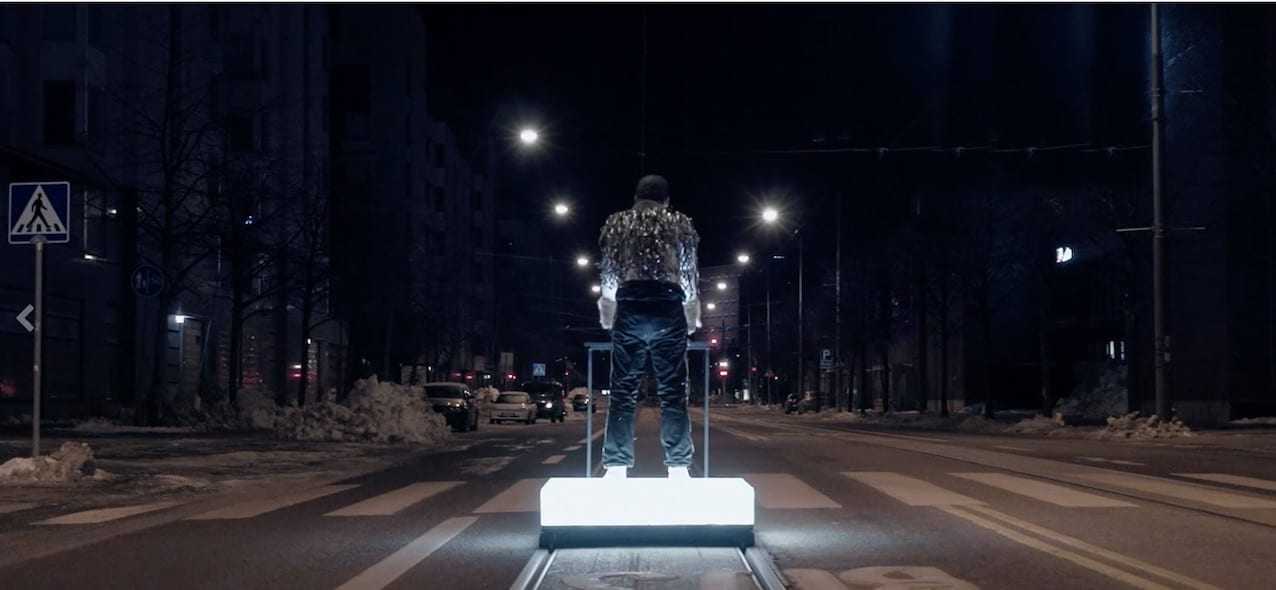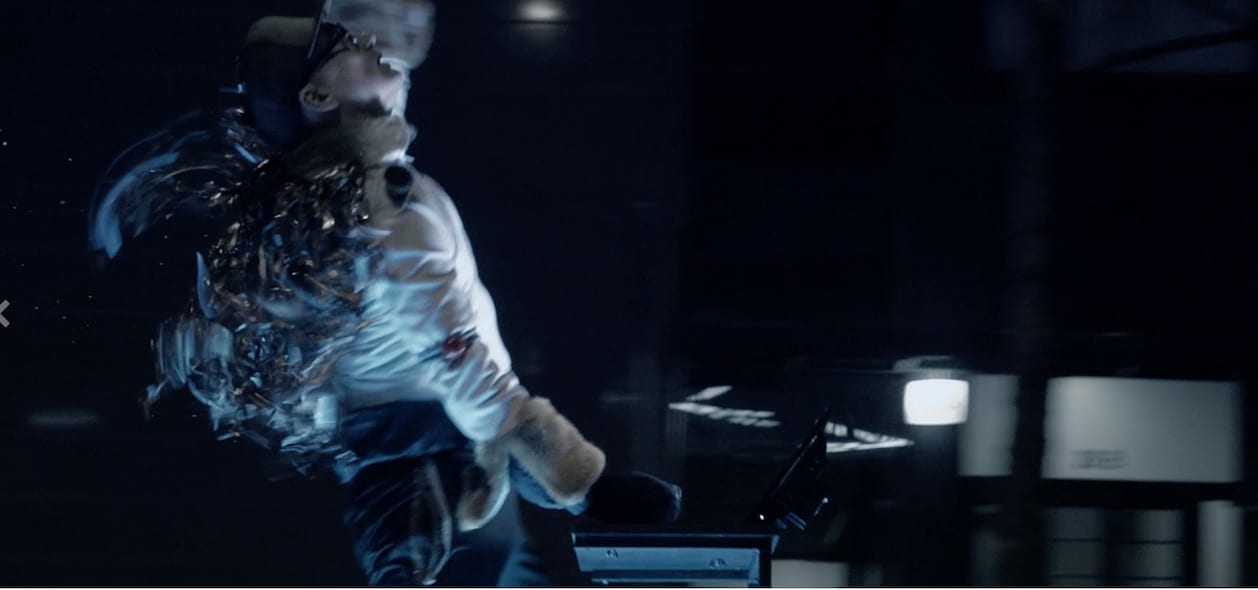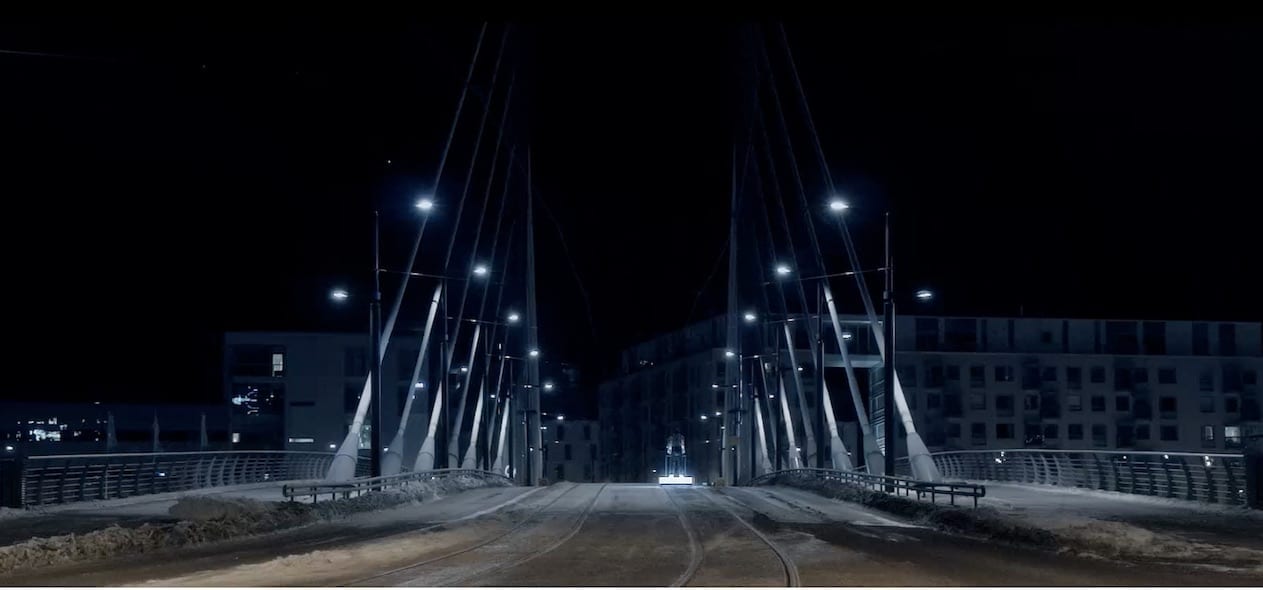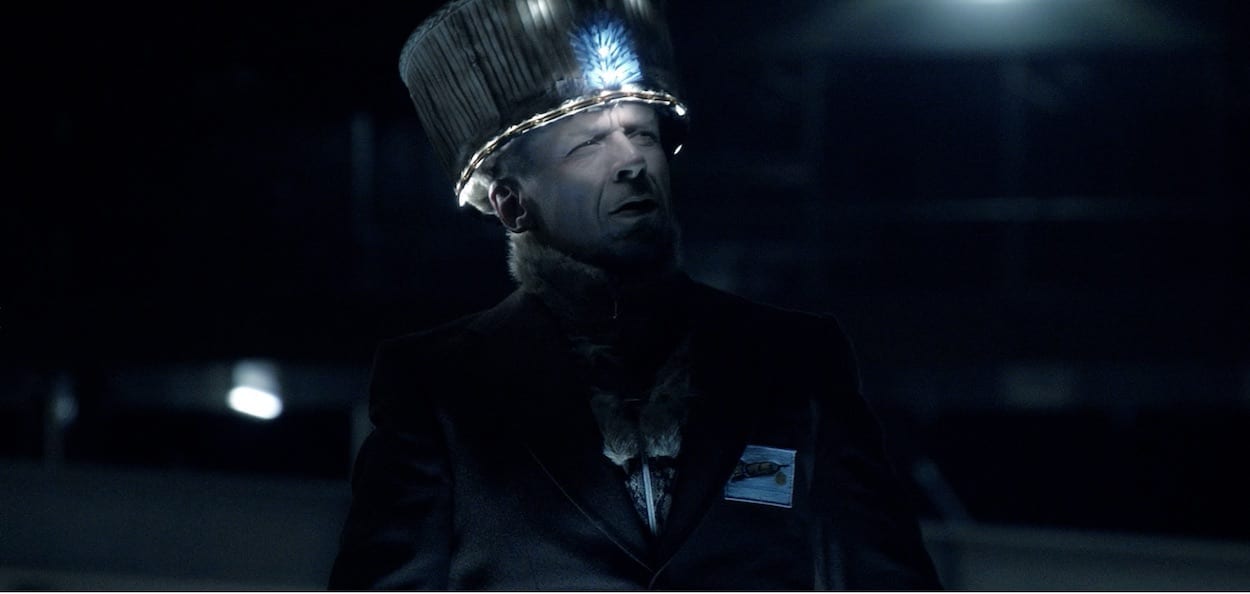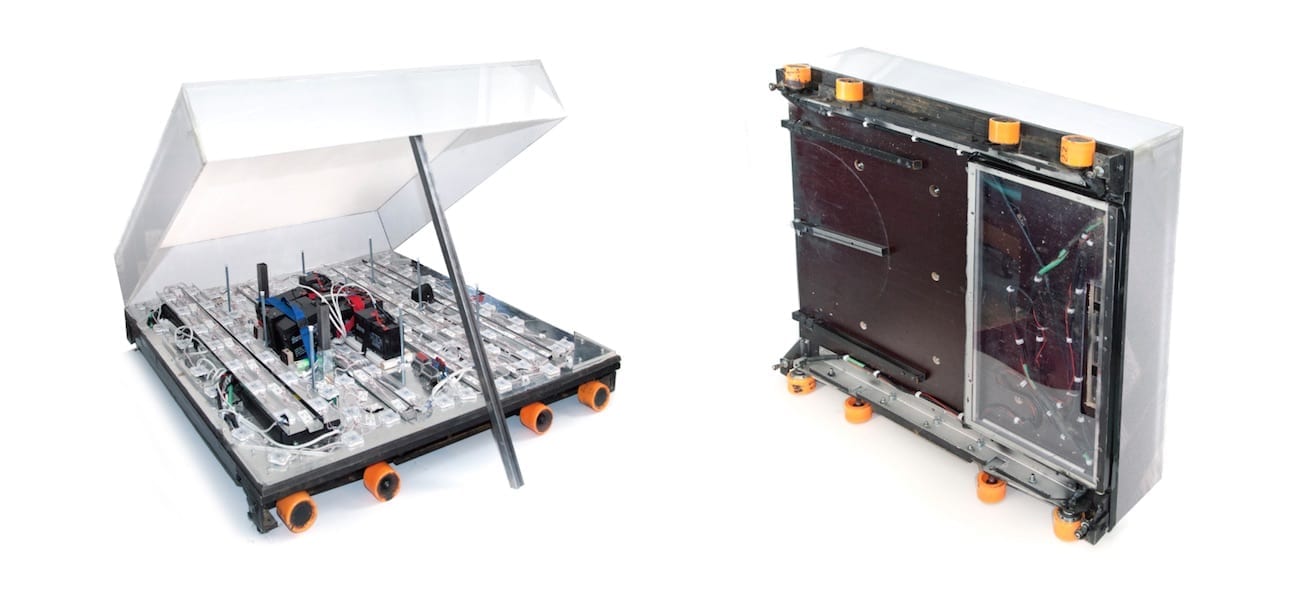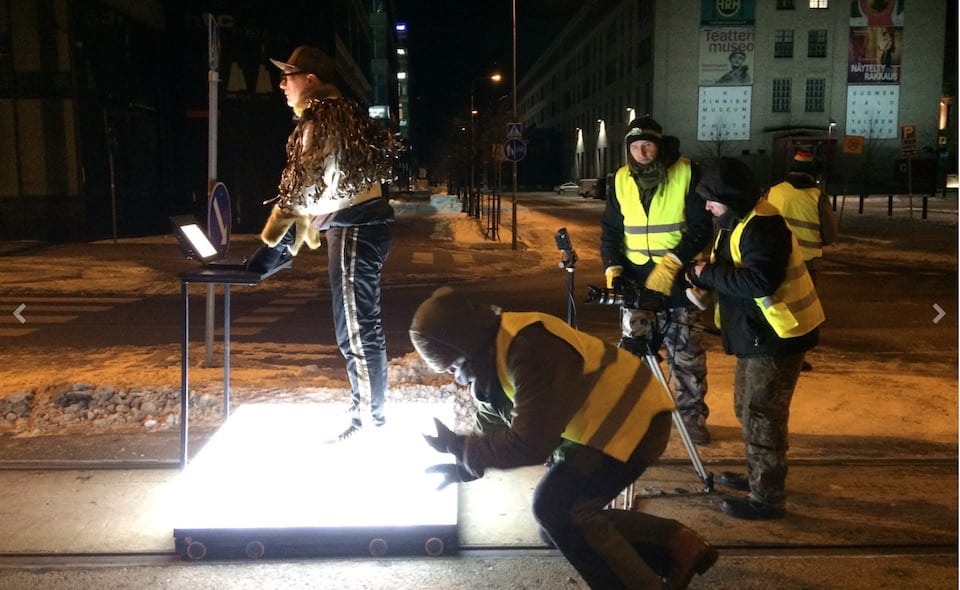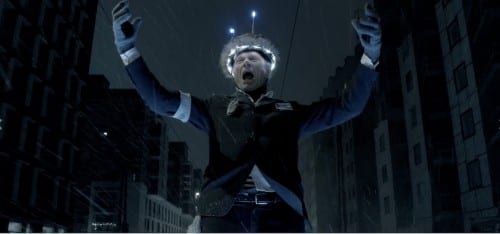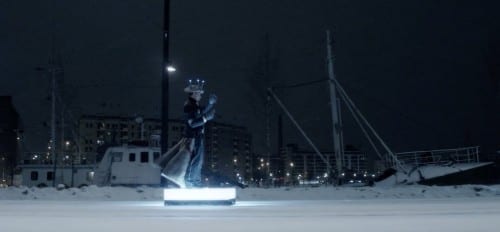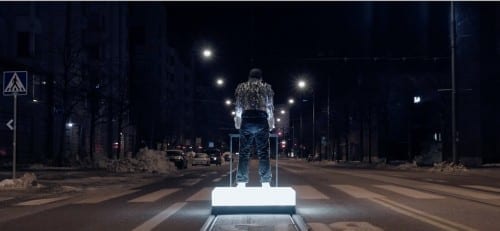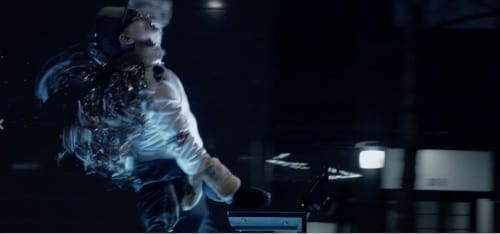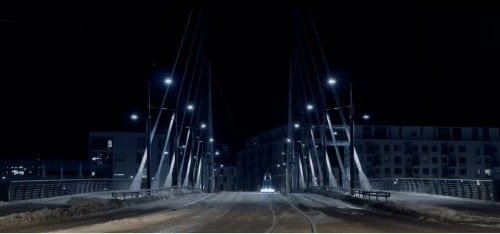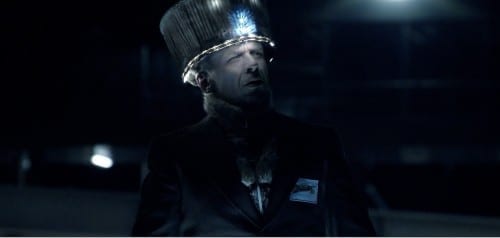The music surely came first but how did your idea for the three musicians, known as Pohjonen Alanko, moving on illuminated platforms through the icy night streets of Helsinki come to you? Was it through conversations with the band or did you simply suggest it to them?
Some years ago I happened to see a Czech artist, Tomáš Moravec’s videoclip of him gliding on tram tracks in Bratislava on a wooden pallet. I have always liked trains, tracks and trams and the idea evolved in my head. I thought it would be great to picture a musical group on separate, self-illuminated platforms with electrical engines and the video to be shot at night time and in winter.
One of the musicians of the “Northern Lowland”, Kimmo Pohjonen, is a good friend of mine and I mentioned once that I had this idea and wanted to realize it with a band. He and the rest of the guys were exited about it and so I started to plan how to carry it out the coming winter.
Please tell us how the original idea evolved – were there many ideas discarded in favour of others?
Pohjonen, Alanko and Norvio are very well known artists with many simultaneous musical projects happening in Finland and abroad with tight schedules, very busy people so to speak. I was very happy that the band had faith in our video project from the beginning and everybody involved had a very strong feeling about it. I had free hands with the script, locations and realisation of the video. The guys gave me the songs from the upcoming “Northern Lowland” album from which I suggested the best track to the idea. The basic theme of the band “of finding each other” was already there but the shamanistic music set up the frame – the scenes for the visual story came up as I listened to the song over and over again and then made the final storyboard based on that.
Did you spend considerable time rehearsing with Pohjonen Alanko?
Before the video I shot the stills and made the cover for the new album with the guys on the illuminated platforms to go with the video. The shooting-timetable of the video was very tight and we had to plan everything carefully beforehand, but we did not have any rehearsing on the moving platforms or such.
Most of the crew members work and have studios in the former mental hospital “Lapinlahti” in the centre of Helsinki. With assistant director Sami Laitinen, cinematographer Jari Järvi and technical magician Risto Puurunen we thought of all possible obstacles and went through all scenarios beforehand. With Puurunen we planned, built and tested the platform for weeks inside and on the tracks.
The totally crazy production must have been the happiest one in the world, everything worked perfectly finally and we had tons of fun working on it. Pohjonen, Alanko and Norvio are amazing creative artists and we had only little conversations about how to perform on the video. But on the shooting nights the guys totally understood the plan, the script and our wishes and threw themselves into a powerful performance despite the really harsh and difficult conditions.
How did the design of the costumes, especially the illuminated helmets come about? Were the platforms and the helmets really illuminated while you were shooting?
The band perform gigs in these great costumes created by multi-talented Tero Jartti. The helmets are made of an old football turned upside down, tooth and dish brushes and a lamp shade. There was actually only one illuminated platform on which the three artists where filmed separately and then joined in the edit and post-production.
There was a nightly dog walker and two disturbing advertisement signs digitally removed. Except for the low-fi lighting effects and sparks in the solo part of Tuomas Norvio, the guy with the cap, everything you see on the video was shot in real winter street circumstances.
The eight-wheel platform had two remotely controlled electrical engines, eight motorcycle batteries and 400 ledlights inside the acrylic lightbox. The artists controlled the speed of the platform with the remote controls in their hands and had a supporting metal bar hidden behind their back so they didn’t fall off while dashing on the icy tracks. Happily nobody was injured even though it didn’t have any brakes.
How did you convince Helsinki Transport Department to allow you to shoot on the tram lines?
The City of Helsinki has opened itself to many grassroot events created by the citizens and have given green light to projects that wouldn’t have been possible before. The City of Helsinki and the Transport Department was totally on our side from the beginning and helped with all permissions and used their contacts to make it happen.
We presented exact plans, maps and timetables of our shooting routes and were allowed to film on the tram tracks on three nights between 2am and 5:30am. To get the most of the tight timetable we started every night at midnight with close-ups with the illuminated platform placed on a moving trailer and then moved to the tracks as soon as possible.
What were the main challenges of shooting at night in a snowy drizzle?
Our film crew of seven was like a nightly troop with a mission. We started the nights with a warm meal together, dressed up our arctic outfits, packed our vans and went to fight the harsh conditions. One of the main things that made things work on screen, was that we treated the performers really well and let them get warm in a separate van as soon as they wanted to. We had temperatures of 15 celsius below zero with a strong wind that makes it feel almost double. After finishing the last frames the skies opened and almost a meter of snow came down. It was the last moment we could have made the video on those tracks that winter.
There’s a meticulous fusion of visuals with the music – Did you storyboard in detail before the shoot or did the film evolve in the edit?
I am glad if the fusion can be seen and heard, I really tried to weave the image and sound together. Because of the special shooting conditions, timetable and location on tracks, I had to draw a very precise storyboard beforehand with planned camera angles and set ups. The amazing thing is that we got 99% of the sequences and planned shots made. Our team worked like clockwork and with good humor. We even got the last scene where the guys come together – despite that the city was waking up and we were holding back honking trucks and cars coming from the Swedish car ferry.
How did you learn to edit?
I have studied visual communication, photography and arts in different schools in three countries but film and editing has come to me just lately and self-taught. Having excellent professionals of the field as friends and neighbours has helped me a lot, but also a bunch of web-tutorials about the technical stuff. I am also a drummer and I really like the similarity in creating the rhythm in editing and with moving images. The science of beat seems to help a lot.
This is one of your first films but there are hidden depths here – please tell us the headlines of your previous experience connected to filmmaking.
I have just begun in film and made only a trailer for the Finnish film festival “Love&Anarchy” and a couple of music videos, but nothing in this scale and effort. Most of my professional trail I have worked as a freelancer in visual journalism, communication and advertisement parody-activism. In them visual hooks, hidden or direct meanings play an important role. I have longed for some kind of more intuitive and ambiguous expression and film appears to be perfect in that sense. As in visual journalism, I have always liked the fact that it can be seen by a large public and not just an exclusive audience. Like in this music video – maybe the nuances or hidden depths will pass the majority – but still can give something to the viewer. I have a couple of more ideas I want to express in this form of art.
How would you sum up your childhood?
I have had the advantage of dual citizenship of Finnish and German nationalities. We lived in a small costal village south of Finland but visited relatives and friends in Germany regularly. My father worked for the German Seamen’s Mission as sort of a social worker in two harbours in Finland and took me almost every day with him to the ships of different flags with multicultural crews. For a schoolboy, this opened an exceptional view to the world and the drive to see more of it. I wouldn’t call my family cultural orientated but our parents were really tolerant with our experiments with music, play and new ideas in general.
Where do you call home? Have you always lived in Finland?
I grew up in Finland but after a couple of years of study in Helsinki I stayed in Xalapa, Mexico for four years; first a year studying art and photography and then opened up a cultural bar with bands and exhibitions. The contacts to the art school made the place turn out to be a hit in the cultural scene of the city. After having enough of it I returned to Europe and got to study photography and visual communication at the Berlin Hochschule der Künste. After a two years stay in Germany I returned back to Finland and haven’t regretted it since. I really love Helsinki – even if the music video might not show the most beautiful or idyllic side of it at first glance.
Is there anything else you wish to share?
It is great how short films and music videos circulate and get to be shared on the net. I want to say thanks for lifting up the amazing video “Dance of War” by Cyprien Clément Delmas on your site. I hadn’t seen it yet and it just blew my mind.
LINKS
